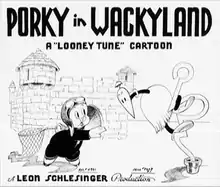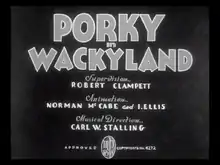Porky in Wackyland
Porky in Wackyland is a 1938 Warner Bros. Looney Tunes animated short film, directed by Bob Clampett.[3] The short was released on September 24, 1938, and stars Porky Pig.[4]
| Porky in Wackyland | |
|---|---|
 Lobby card | |
| Directed by | Robert Clampett |
| Produced by | Leon Schlesinger |
| Story by | Warren Foster |
| Starring | Mel Blanc Billy Bletcher Tedd Pierce Danny Webb[1] |
| Music by | Carl W. Stalling |
| Animation by | Norman McCabe I. Ellis Vive Risto John Carey Robert Cannon[2] |
| Layouts by | Bob Clampett |
| Backgrounds by | Elmer Plummer |
Production company | |
| Distributed by | Warner Bros. Pictures The Vitaphone Corporation |
Release date |
|
Running time | 7:23 |
| Country | United States |
| Language | English |
In 1994, Porky in Wackyland was voted No. 8 of The 50 Greatest Cartoons of all time by members of the animation field.[5] In 2000, it was deemed "culturally, historically, or aesthetically significant" by the United States Library of Congress, which selected the short for preservation in the National Film Registry.
Plot

A newspaper shows Porky Pig traveling to Africa to hunt the rare dodo bird, worth $4,000,000,000,000 p.s. 000,000,000 dollars. Porky uses his airplane to go to Dark Africa, then Darker Africa, and finally lands in Darkest Africa. When Porky lands, a sign tells him that he's in Wackyland ("Population: 100 nuts and a squirrel"), while a voice booms out "It can happen here!" Porky tiptoes along the ground in his airplane and he is greeted by a roaring beast, who suddenly becomes effeminate and dances away into the forest.
He watches as the sun is lifted above the horizon by a tower of stacked creatures. Nearby, another creature rises out of a tall flower, playing "The William Tell Overture", using his nose as a flute. The creature launches into a wild drum solo, plays a tiny piano, and plays its nose like a horn, which brings out a group of odd creatures, including a rabbit dangling in midair from a swing that seems to be threaded through its own ears, a small creature wearing large female mannequin legs who encourages the rabbit to swing faster, a peacock with a fantail of cards, an upside-down creature walking with giant bare feet in his arms (replacing his hands) while wearing a hat on his legless rear end, a goofy-looking creature wearing large glasses in a small pot, a scooter-like creature, a creature with two steamboat pipes on his back, a four-legged creature with a waffle iron-like mouth, three fish swimming in midair (the first holding an umbrella, the second wearing an anchor, and the third with a periscope on its back), a round creature with long legs on its sides, and an angry criminal imprisoned behind a free-floating barred window that he holds in his hands while a small policeman on a wheel appears and hits him on the head with a large stick. As Porky tries to find the do-do, he comes across a duck singing "Mammy!", a horn-headed creature, a conjoined cat and dog hybrid creature spinning around like a tornado while they fight, and a 3 headed stooge whose heads argue and fight amongst themselves, but temporally stop their fight to tell the viewers that their mother was scared by a pawnbreaker's sign, while a small creature with a light bulb on its head translates their gibberish speech.
Finally, the Dodo appears. Porky tries to catch it, but it plays tricks on him. The dodo pulls out a pencil and draws a door in mid-air, and instead of opening it and running through, reaches down and lifts up the bottom edge of the door like a curtain, darts underneath and lets it snap back into place for Porky to bump into. At another point, the do-do appears on the Warner Bros. shield logo and slingshots Porky into the ground. Afterwards, the dodo pulls a wall of bricks in the picture and lets him crash into it. Eventually, Porky triumphs when he disguises himself as a bearded paperboy, shouting "Extra! Extra! Porky captures Dodo!", before hitting the bird with a mallet. Porky loudly proclaims to the audience that he has captured the last dodo. The dodo mockingly replies, "Yes, I'm really the last of the dodos. Ain't I, fellas?". A multitude of dodos appear, all yelling out, "Yeah!". They and the Dodo all howl, which allows him to escape and stand on Porky's head.
Reception
Steve Schneider's 1998 That's All Folks! The Art of Warner Bros. Animation writes that with this short, "the lord of cartoon misrule, Clampett established conclusively that in animation, realism is irrelevant."[6]
In the 2001 Masters of Animation, John Grant writes that "this short, in its cumulative effect, is more wildly inventive than anything even [Tex] Avery had produced for Warners."[7]
Animation historian Steve Schneider writes, "No mere Looney Tune, Porky in Wackyland was Warner Bros. Emancipation Proclamation. Building on the creaky liberties inaugurated by director Tex Avery, here Bob Clampett scoffs and shreds the conventions — realism, literalism, infantilism, cutesiness, and worse — that, with the ascendancy of Disney, had come to caramelize cartooning. By reminding us of animations' horizons — namely, none at all — this anything-goes film illustrates Sigmund Freud's notion that humor arises from breaking taboos. And breaking taboos is something that animation, with its limitless freedom, is uniquely gifted to do."[8]
Follow-ups and derivative works

Much of the Wackyland sequence was adapted and reused by Clampett for inclusion in his 1943 short Tin Pan Alley Cats. A color remake of Porky in Wackyland was supervised by Friz Freleng in 1948. Re-titled as Dough for the Do-Do, the remake was released in 1949. The films were nearly identical, in many cases appearing to match frame-by-frame in certain details, albeit with Porky's appearance updated (by redoing most of the animation of the character), the voices having evolved (with less use of speeding-up) and all of the backgrounds being different. Dough for the Do-Do was produced in Technicolor, but was originally released in Cinecolor due to a dispute with the Technicolor corporation. Later reissues were printed by Technicolor.
There were at least two Terrytoons plagiarizations of Porky in Wackyland in the 1940s or 50's. Dingbat Land (1949)[9] starred Gandy Goose and Sourpuss. The role of the Do-Do was taken by a minor Terrytoons character, Dingbat.[10] The second film, a more direct plagiarization of the Porky Pig/Do-Do cartoons, starred a British hunter and a Do-Do stand-in. The creature didn't talk, but made strange hooting noises, and flung flames from a tuft of hair on top of its head.
Tex Avery, for whom Clampett worked as an animator in the mid-1930s, borrowed strongly from this cartoon for his 1948 MGM cartoons Half-Pint Pygmy (in which the characters, George and Junior, travel to Africa in search of the world's smallest pygmy, only to discover that he has an uncle who's even smaller) and The Cat That Hated People (where the cat travels to the moon and encounters an array of characters similar to those in Clampett's Wackyland, e.g., a pair of gloves and lips that keep saying "Mammy, mammy", just like the Al Jolson duck in Porky in Wackyland). Clampett would again use the Three Stooges parody when a later creation of his, Beany and Cecil, faced the "Dreaded Three-Headed Threep".
According to writer Paul Dini, the Do-Do Bird is the father of Gogo Dodo, a character on the 1990s animated TV series Tiny Toon Adventures. A small clip from the film was used in a Slappy Squirrel segment on another Warners animated TV series of the 1990s, Animaniacs. The segment, titled "Critical Condition", featured Porky in Wackyland as part of a fake LaserDisc release. The Do-Do Bird has made occasional guest spots in the DC Comics Looney Tunes comic book, being colored in grayscale as opposed to the rest of the art being in color. The character makes an appearance in the Wii game Looney Tunes: Acme Arsenal as an unplayable character. He is given a first name, Yoyo the Dodo. Yoyo can also be seen as a brief cameo in the beginning of Who Framed Roger Rabbit.
See also
- Looney Tunes and Merrie Melodies filmography (1929–1939)
- Looney Tunes and Merrie Melodies filmography (1940–1949)
- Looney Tunes Golden Collection Porky in Wackyland on Volume 2 (Disc 3) and Dough for the Do-Do on Volume 1 (Disc 2)
References
- Hartley, Steven (23 November 2012). "Likely Looney, Mostly Merrie: 216. Porky in Wackyland (1938)". Likely Looney, Mostly Merrie. Retrieved 4 October 2020.
- "Porky in Wackyland Breakdown (#14)". Retrieved 19 December 2020.
- Beck, Jerry; Friedwald, Will (1989). Looney Tunes and Merrie Melodies: A Complete Illustrated Guide to the Warner Bros. Cartoons. Henry Holt and Co. p. 77. ISBN 0-8050-0894-2.
- Lenburg, Jeff (1999). The Encyclopedia of Animated Cartoons. Checkmark Books. pp. 124–126. ISBN 0-8160-3831-7. Retrieved 6 June 2020.
- Beck, Jerry (1994). The 50 Greatest Cartoons: As Selected by 1,000 Animation Professionals. Turner Publishing. ISBN 978-1878685490.
- Schneider, Steve (1988). That's All, Folks! : The Art of Warner Bros. Animation. Henry Holt and Co. p. 60. ISBN 0-8050-0889-6.
- Grant, John (2001). Masters of Animation. Watson-Guptill. p. 55. ISBN 978-0823030415. Retrieved 23 July 2020.
- Beck, Jerry, ed. (2020). The 100 Greatest Looney Tunes Cartoons. Insight Editions. p. 142. ISBN 978-1-64722-137-9.
- "Classic Cartoons". classiccartoons.blogspot.com.
- "Archived copy". Archived from the original on 2007-03-11. Retrieved 2006-08-19.CS1 maint: archived copy as title (link)